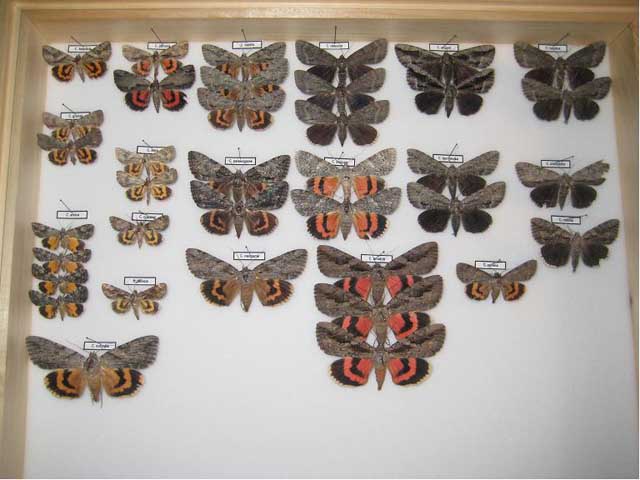To avoid excessive download times I have split the original Indiana Catocala page into two sections. To visit the
smaller Catocala with yellow, orange, salmon or pinkish underwings,
click on Indiana Catocala.
Solid Black Underwings: Smallest to Largest, Similar Species Paired
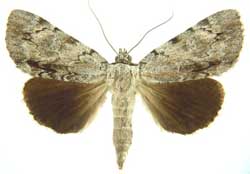
|
Catocala miranda,
Miranda Underwing, (wingspan: 37-45mm). unconfirmed, likely present
Fw plain pale grey with very light and fine black lines, darker and wider near costa.Hw black with white fringe at apex,
turning to grey along om.
Miranda smaller than orba; miranda has dark bar just above im in median area, projecting toward anal angle.
|
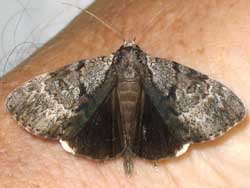
|
Catocala andromedae,
Gloomy Underwing, (wingspan: 40-50mm).
Black underwings and dark grey fringe of hws,
dark inner margin of fws help to identify
this species. Very dark "flying saucer" shape, adjoining
subreniform spot to midpoint of am line.
"Teeth" of pm line are short, blunt,
outwardly edged with white. Subterminal line outwardly
edged with white.
|
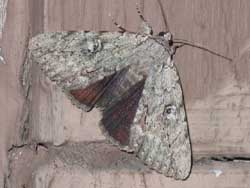
| ** 8781
judith,
Judith's Underwing, (wingspan: 45-55mm), yes,
One of the smaller "black" underwings.
Fw: uniform
light grey with thin and only slightly darkened antemedial, median
and postmedial lines. No darkened dashes (slight anal dash)
or transverse lines. The reniform area is slightly darkened while the
area just before the subterminal line is a bit lighter. Note absence of
hw white fringe.
Joe Garris photo.
|
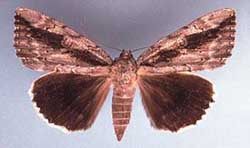
| ** 8782 Catocala flebilis, yes;
Mournful, wingspan: 54-65mm, yes.
Diffuse black band runs from basal area to
outer margin just below apex, interrupted by pale grey
subreniform spot. Reniform spot is filled with brown; there is
additional brown outside postmedial line. No anal dash
as there is in angusi. The hindwings have white fringe. J. K. Adams
image.
|
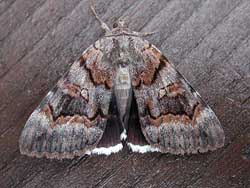
| ** 8773
Catocala epione , yes;
Epione Underwing, wingspan: 55-65mm
The pm line is squared and has a brown band and then a light band
just outside the line. The hindwing is black with pure white fringe
with no barring.
John Himmelman image.
|
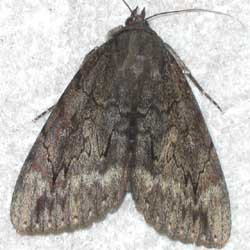
| Catocala residua,
the Residua Underwing, (wingspan: 58-73mm), yes,
is distinguished from Catocala obscura by the grey hindwing
fringe of residua.
Catocala obscura has white to off-white fringe and tends to be
less common in northern portions of its range. The forewing
subterminal line/area of Catocala residua tends to be pale as
is its open, elongated subreniform spot.
Like C. obscura it is otherwise devoid of significant markings
except for the hint of a dark bar running from the basal area
through the reniform spot to the outer margin just below the apex.
|
Catocala residua, Jay County, July 27, 2009 - September 24, 2009, Scott Mescher.
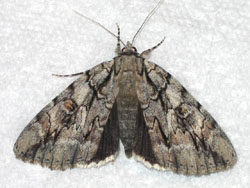
|
Catocala retecta;
wingspan: 60-75mm
Note the light coloured, elongated and open subreniform spot
which interrupts the dark, diffuse ark running through the center of
the wing from the basal area (body-wing juncture) to the forewing
apex. The center of the reniform spot is brown and there is a brown
area just below the costa running to the inner margin just outside the pm
line. The off-white hindwing fringe is only lightly checked along the
wing veins.
|
Catocala retecta, Jay County, September 4, 2009 - September 22, 2009, Scott Mescher.
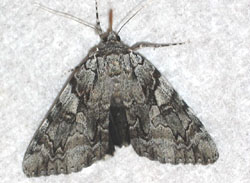
| Catocala dejecta,
(wingspan: 56-73mm; Hodge #8790).
The Dejected Underwing is quite similar to Catocala retecta.
Here the light coloured subreniform spot is also open, but it has a
distinct "pork-chop" shape and separates a much darker median area
below the subreniform spot from a very light area to the costa
above the spot.
The lower quarter of the submarginal area is also
much darker in C. dejecta than in C. retecta.
Full size Joe Garris photo.
|
Catocala dejecta, Jay County, September 20, 2009 - September 24, 2009, Scott Mescher
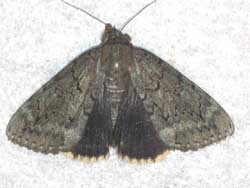
| ** 8784
obscura, yes;
the Obscure Underwing, (wingspan: 58-72mm),
has dull, grey forewings, usually void of any significant dashes or
streaks, providing for easy identification. The antemedial, median
and postmedial lines of obscura are faint and the subterminal line
region is only slightly paler than the rest of the forewing.
The hindwing fringe is off-white and lightly checked on the veins.
Joe Garris photo.
|
catocala obscura, Jay County, July 27, 2009 - September 26, 2009, Scott Mescher.
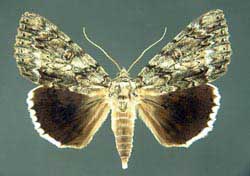
|
ulalume;
Ulalume Underwing; 62-75mm.
Fw colouration is a mottled light to dark grey with no strongly contrasting lines, dashes or bars.
At the inner margin the antemedial line ends with in a very light coloured crescent. The subrenifrom spot is also light coloured and "comma" shaped.
The hindwing is black and the fringe is pure white with thin, sharp (pointed) checking.
|
Catocala ulalume, Jay County, September 17, 2009 - September 24, 2009, Scott Mescher.
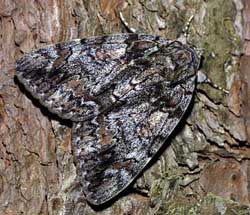
| ** 8794
Catocala lacrymosa;
Tearful Underwing, wingspan: 60-82mm
The forewing is highly variable with a mixture of black, brown
(wing tips and outside postmedial line) and dark grey scaling.
There are usually whitish crescents, along the inner margin at the
base of the antemedial and postmedial lines.
The hindwings are black with white checkered fringe, turning black
near the anal angle.
|
Catocala lacrymosa, Jay County, August 13, 2009, Scott Mescher.
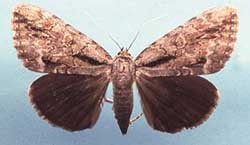
| ** 8783 Catocala angusi
WO; Angus' Underwing, 60-74mm; Dark dashes/streaks in basal & anal areas distinguish
this species. Reniform spot has light brown filling.
Hw fringe black except for white region at apex.
Form lucetta has broad black band from basal area to
outer margin, broken only by reniform & subreniform spots.
James K. Adams image.
|
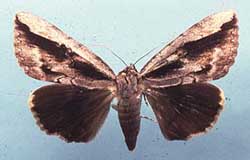
| ** 8783 Catocala angusi
WO; Angus' Underwing, 60-74mm; Dark dashes/streaks in basal & anal areas distinguish
this species. Reniform spot has light brown filling.
Hw fringe black except for white region at apex.
Form lucetta has broad black band from basal area to
outer margin, broken only by reniform & subreniform spots.
James K. Adams image.
|
Catocala angusi, Jay County, August 3, 2009 September 1, 2009, Scott Mescher
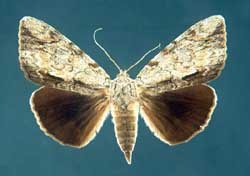
| ** 8791
Catocala insolabilis;
Inconsolable, wingspan: 65-75mm
The forewing is light grey with blackish shading along the inner
margin. The antemedial and postmedial lines are thin.
The hindwing fringe is very narrow and grey, becoming whiter toward
the apex.
The ventral surface clearly distinguishes insolabis, being almost
completely black except for some white in the basal area.
Vernon A. Brou image.
|
Catocala insolabilis, Jay County, August 13, 2009, Scott Mescher
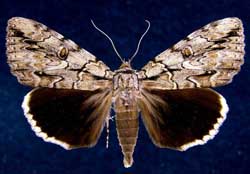
| Catocala luctuosa,
Underwing, (wingspan: mm).
Fw light grey (yellowish tint) clearly marked with a basal dash that continues with another dash through the
am line, followed by another anal dash almost forming bar parallel to im.
Hw fringe white, lightly barred at veins.
Fw pml "teeth" elongated and dark, continuing dark dar emanating from om just below apex.
|
Catocala luctuosa, Jay County, September 24, 2009, Scott Mescher.
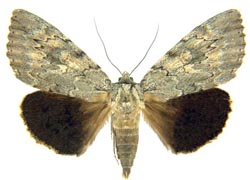
| ** 8780
Catocala robinsoni;
70-80mm;
Fws relatively plain pale grey.
Female has basal dash, absent in male.
Currata French, 1882, is female form, having weak basal dash.
Rare form missouriensis Schwarz, 1915, has dark, broad bar
extending from basal area to om just below
apex. Lighter grey rnfm and subrnfm spots break bar
in missouriensis, found from PA to FL.
White fringe on hindwings; prominent bands on ventral surface.
|
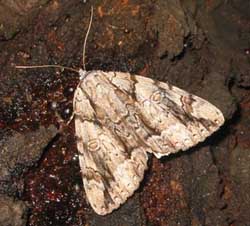
| ** 8792
Catocala vidua;
Widow; wingspan: 70-80mm
The ground colour of the forewing is light grey. There is a
distinguished dark arc running through the top of the reniform spot
to just below the apex. There are heavy, dark anal and basal
dashes, connecting to a dark median bar, running parallel to the inner margin.
The am line is thick and black in its upper half.
The reniform spot consists of two almost
concentric irregular ovals.
The subreniform spot is light, open, but constricted as it
meets the pm line.
The hindwing is black with broad, white fringe, only lightly
interrupted.
Marie Winn image. |
Catocala vidua, Jay County, September 10, 2009 - September 12, 2009, Scott Mescher.
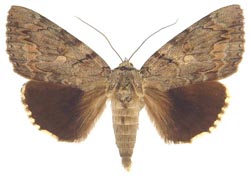
| Catocala agrippina,
Underwing, (wingspan: mm). unconfirmed possiblity in southern Indiana
Head and body blackish grey (dorsal) and greyish white (ventral). Male fws grey-black with some reddish brown
(distinguishing characteristic); transverse lines black, darker toward costa, lighter near im.
Reniform indistinct, brown, sub-reniform almost obsolete, lighter than surrounding areas.
|
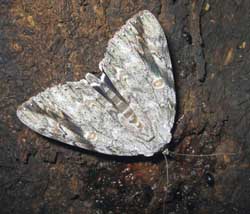
| ** 8793
Catocala maestosa SM,
Sad Underwing, wingspan: 78-98mm
Maesotsa is quite similar to, although usually larger than, vidua.
Both have the dark arc from the costa, above the reniform spot, to
the outer margin just below the apex. Maesotsa, however, lacks the
dark bar, found on vidua, parallel to the inner margin.
The reniform spot is brown and there is brown shading just outside
the postmedial line.
The hindwing fringe is white, narrow and heavily barred.
|
Catocala maestosa, Jay County, September 4, 2009 - September 22, 2009 , Scott Mescher.
|
Large Black Underwings (Banded): Wingspans: 70-80mm
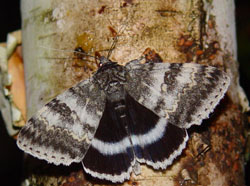
| ** 8803 Catocala relicta
;
Forsaken, White, Relict; 70-80mm:
Considerable variation with regard to black/white
concentrations on fws.
Typical specimens have basal and subterminal areas with
blackish scales.
Black hws, with brilliant even white inner band and
white fringe, are distinctive. June until October.
|
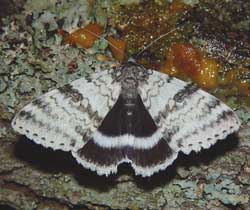
| ** 8803 Catocala relicta
;
Forsaken, White, Relict; 70-80mm:
Considerable variation with regard to black/white
concentrations on fws.
Form clara: basal and subterminal
areas predominantly white.
Typical specimens have basal and subterminal areas with
blackish scales. Black hws, with brilliant even white inner band and
white fringe, are distinctive. June until October.
|
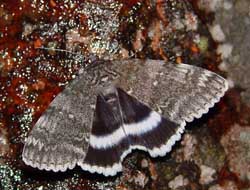
| ** 8803 Catocala relicta
;
Forsaken, White, Relict; 70-80mm:
Considerable variation with regard to black/white
concentrations on fws.
Form phrynia:
evenly dusted with grey over entire forewing.
Typical specimens have basal and subterminal areas with
blackish scales. Black hws, with brilliant even white inner band and
white fringe, are distinctive. June until October, poplars and willows
|
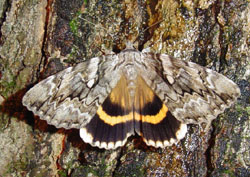
| ** 8802
Catocala cerogama;
Yellow-Banded; 70-80mm.
Several different forms. Pm line distinct, dark
and has elongate pair of projections. Pm and am lines meet inner
margin in relative proximity. Closed subreniform spot
lighter than surrounding areas, shaped a bit like an
arrowhead with point toward body. Hws are
distinctive. Jean-Benoît Duval image. |
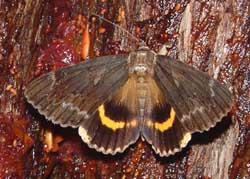
|
Form ruperti: Forewings are almost uniform grey-brown with white scales outlining subterminal line.
The hindwings are
distinctive. Tim Dyson image. |
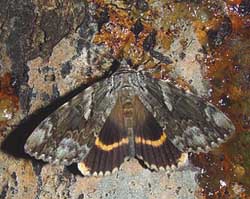
|
Form bunkeri: Forewings are dark in median and basal areas.
Hw golden band is reduced in thickness. Basal hairs are brown instead of yellow.
The hindwings are
distinctive. Tim Dyson image. |
Large Orange-Salmon Underwings: Wingspans: 65mm, usually 70-95mm
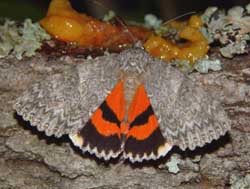
| ** 8822
meskei; Meske's Underwing;
wingspan: 65-75mm
The forewings are less distinctly marked compared to unijuga and
there is some red-orange at the hindwing apex and just inside the
fringe along the outer margin in meskei that is lacking in unijuga.
The forewing subreniform spot is opened or connected to the
postmedian line. The hindwing postmedian band is nearly straight,
turned in and tapering near the anal angle.
Tim Dyson image. |
Catocala meskei, male and female, recto and verso, Portland, Jay County, Indiana, Scott Mescher.
Catocala meskei, Jay County, August 25, 2009 - August 30, 2009, Scott Mescher.
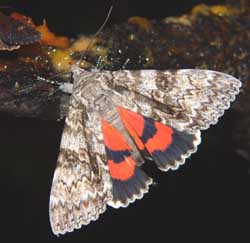
| ** 8821
semirelicta; Semirelict Underwing;
wingspan: 65-75mm; unconfirmed, unlikely possibility
The forewing ground colour is white with dark lines and shadings. A
diffuse dark bar runs from center of basal area to the outer margin a
few mm above the anal angle. Note regular dentation of st line.
The inner black bar on the lower wing usually terminates well before
the inner margin.
The form "atala" has a forewing that is uniformly grey.
Unijuga is usually larger and has less contrasting black lines. The
inner black bar on unijuga usually reaches the inner margin.
Tim Dyson image.
|
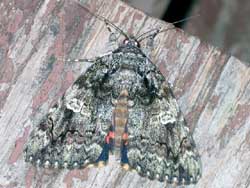
| ** 8801
Catocala ilia; Ilia;
wingspan: 65-82mm
Catocala ilia specimens come in several different forms, but
most of them have the characteristic white area in and around
the reniform spot. There is also a diffuse dark arc running from this
spot to just below the outer apex.
Except in worn specimens and the darkest forms,
the white dots near the outer margin of the forewing are in character
with the overall "contrasting" appearance of this moth.
|
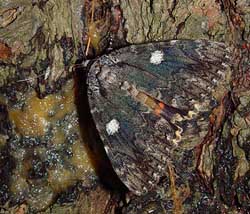
| ** 8801
Catocala ilia; Ilia;
form conspicua.
In this form the entire reniform spot is heavily suffused with white scaling on
an otherwise darker ground colour. Hence the form name "conspicua".
Tim Dyson image.
|
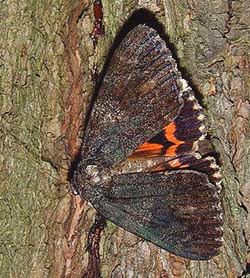
| ** 8801
Catocala ilia; Ilia;
form satanas.
In this melanic form the entire forewing, including the reniform spot is very dark. Hence the form name "satanas".
The dark basal streak is still evident on this form.
Tim Dyson image.
|
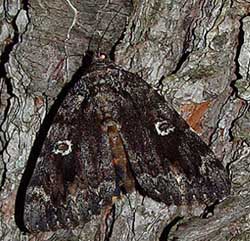
| ** 8801
Catocala ilia; Ilia;
form normani.
In this semi-melanic form the entire forewing, excluding the reniform spot, is relatively dark.
The brownish, kidney-shaped center of the reniform spot is outlined in white.
Tim Dyson image.
|
Catocala ilia, Jay County, September 22, 2009, Scott Mescher.
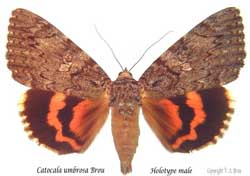
| ** 8857.1
Catocala umbrosa;
mm;
Double brown am line, inward line fainter, filled with off white; reniform spot brown
center outlined in black , off white and black again; subreniform, large, pale brown, closed.
Pm line wit htwo elongated upper teeth, next tooth reduced, next two progressively longer, rounded,
final lobe rounded and shorter. HW with dark scaling/hairs in basal median area along im
|
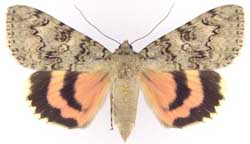
| ** 8808 luciana;
Luciana Underwing, 70-80mm. unconfirmed
Pale grey brown forewing with very distinct am
& postmedial lines.
Subreniform spot has elongated narrow "tail" that seems to
open through postmedial line.
Inner black band of hw does not reach inner margin.
Fringe is checked and paler (almost yellow) than
salmon ground colour.
|
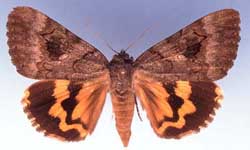
| ** 8772 Catocala consors WO;
Consort, wingspan: 70mm plus.
Fw has irregular am and pm narrow black lines. There is a dark patch
outside the reniform and subreniform spots.
The orange-yellow hindwing pm band tends to be narrow and
irregularly zigzagged. Sometimes the band is wider and slightly less
irregular. James K. Adams image.
|
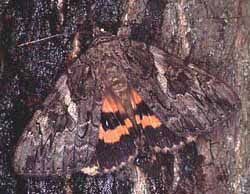
| ** 8771 Catocala piatrix ;
Penitent, wingspan: 68-84mm.
Fw: light-colored band/bar extending from light coloured, triangular
subreniform spot along the am line to the costa. Brown, kidney-shaped reniform spot surrounded in pale grey, outlined in black,
usually with distinct black along wing veins in a dark area outside the reniform spot.
Hw: fringe lightly barred;s lighter in color
than deeper orange on rest of wing.
|
Catocala piatrix, Jay County, September 1, 2009 - September 26, 2009, Scott Mescher.
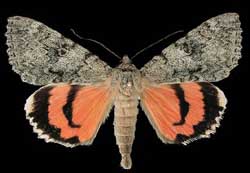
| Catocala junctura;
Joined Underwing; wingspan: 67-85mm.
Forewing is usually dark brownish-gray to evenly powdered
blue-grey w/o significant markings. Doubled reniform spot
often obscure. Thin, slightly darker am and pm
lines run from costa to im and are not widely
spaced at im.
Hindwing is salmon or orange-pink with narrow inner black band
that turns in sharply but does not meet dark-haired im,
distinguishing it from unijuga.
Gary Anweiler image. |
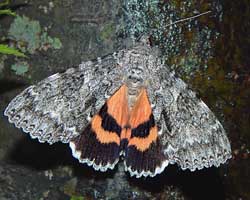
| ** 8805 unijuga;
Once-married; wingspan: 70-90mm
Catocala unijuga has a
fairly wide black inner band (almost reaching inner margin) in the
hindwing and very distinctive patterning in forewing. Meskei tend to
have a narrower band and a dustier (less distinct) looking forewing.
Semirelicta tend to have inner bands that terminate well before the
inner margins.
Also note the very white fringe on both the forewings and hindwings.
Carroll Rudy image.
|
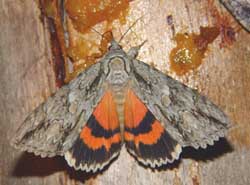
| ** 8806 Catocala parta;
Mother Underwing, 70-85mm.
The black dashes in the basal, subapical and anal areas help to
identify this species. The hindwings may be yellow to
yellowish-orange but more often are salmon-red. Note the
face-head-like markings on the thorax.
In the hindwing, the first (nearest the apex) black protrusion into
the white fringe is "noticeably" larger than the others.
|
Catocala parta, Jay County, September 24, 2009, Scott Mescher.
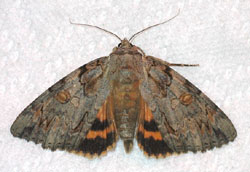
| ** 8798 Catocala neogama;
70-85mm.
Note brown head & thorax & larger size compared to
C. palaeogama. Specimens tend to be slightly smaller
than subnata, and have darker grey brown forewings with more
pronounced markings. Examination of hind tibia is sometimes needed
for identification. Those of neogama tend to be flattened and
unevenly and sparsely spined while tibia of subnata are cylindrical
with spines dense and uniform in distribution.
Joe Garris photo.
|
Catocala neogama, Jay County, August 27, 2009 - September 9, 2009, Scott Mescher.
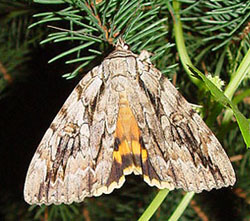
| ** 8797 Catocala subnata;
Youthful Underwing, 75-90mm.
Fws greyish white with blue-grey and light brown scales.
Catocala subnata usually have hws brighter
yellow than neogama. Neogama usually
have basal dash; absent in male subnata, but present in females.
Magnification of hind tibia helps to distinguish the two species:
subnata: cylindrical hind tibia;
neogama: compressed or flattened hind tibia.
subnata: ventral surface of tibia densely covered with evenly
distributed spines;
neogama: ventral surface of tibia sparsely covered with sporadic
spines.
|
Catocala subnata, Jay County, July 27, 2009, Scott Mescher.
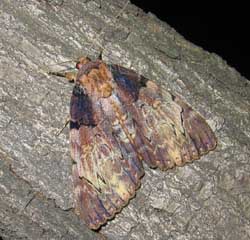
| ** 8796 Catocala nebulosa;
Clouded; wingspan 75-86mm
Moths have a prominent dark brown upper-half-basal patch that extends
to and ends at antemedial line. Apical area also tends to be
brown, much darker than median area but not as dark as basal patch.
The anal angle also has the darker brown scaling.
The pm line is distinct near costa and inner margin, but becomes
weak between the two. It meets inner margin in relative close
proximity to am line.
Closed subreniform spot is large and connects to the
pm line via a thin line.
|
Catocala nebulosa, Jay County, September 23, Scott Mescher.
|
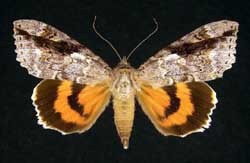
| ** 8804 C. marmorata;
Marbled; wingspan 85-95mm
Dark fw arc runs from costa down through reniform spot to outer margin just below apex.
The subrenifrom spot is light, is bordered inwardly above by a white patch, and is
connected to the pm line by a line rather than being open. probably southern Indiana
|
Medium-Large Pink Underwings: Wingspans: 70-95mm
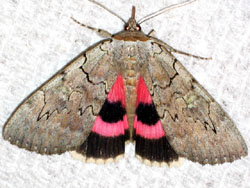
| ** 8833 concumbens
Sleepy Underwing or
Pink Underwing, 60-75mm).
This brown thoracic collar is quite evident in this image as is the
interruption in the pm line by the open subreniform spot.
The white hindwing fringe is only lightly checked
on the wing veins. The vibrant pink bans are
distinct in colour and also in their relatively smooth contour. probably northern Indiana
|
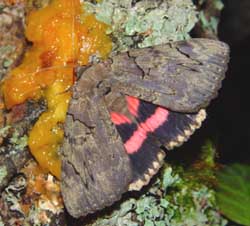
| ** 8832 Catocala cara;
Darling; 70-85mm.
Note deep maroon almost purple cast to fws, mixed with
very pale green. Lower half of am & pm lines is barely
visible. There are no distinctive bars or dashes. The two upper
"teeth" on the pm line are thin and long.
The hindwing bands are pink. There is heavy black checking on the
off-white hindwing fringe. The relatively thick black median band of the
hindwing almost reaches the inner margin which is usually heavily
adorned with dark hairs.
Tim Dyson image.
|
Catocala cara, La Porte County, Leroy Koehn
Catocala cara, Jay County, September 10, 2009 - September 23, 2009, Scott Mescher.
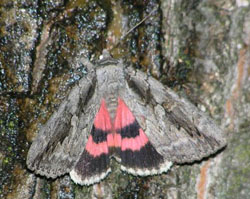
|
** 8834 amatrix
Sweetheart Underwing; (wingspan 75-95mm)
This species is very skittish and frequently hides in caves, under
bridges, under tree bark, etc. by day, resting with head down.
The hindwing patterning and colouration are similar to that of
Catocala concumbens, but the large size (wingspan 75-95mm)
and the dark bar running from the basal area to just below the apex
distinguishes Catocala amatrix.
|
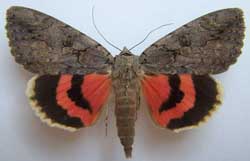
|
** 8834 amatrix form selecta
Sweetheart Underwing; (wingspan 75-95mm)
This species is very skittish and frequently hides in caves, under
bridges, under tree bark, etc. by day, resting with head down.
There are several forms, including selecta (to the left)
which lacks the dark bar on the forewing. Hesseli is a melanic form and
pallida is a very pale form. Possibly hybridizes with C. cara.
|
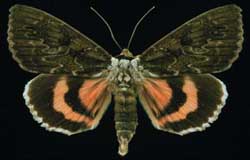
|
** 8834 amatrix form hesseli
Sweetheart Underwing; (wingspan 75-95mm)
Very skittish and frequently hides in caves, under
bridges, under tree bark, etc. by day, resting with head down.
The melanic form hesseli is very dark and displays dark basal hairs in the hindwing.
|
Catocala amatrix, Jay County, August 2009, September 23, Scott Mescher.
|
|
